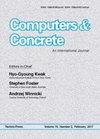Physical test and PFC2D simulation of the failure mechanismof echelon joint under uniaxial compression
IF 3.3
4区 工程技术
Q2 COMPUTER SCIENCE, INTERDISCIPLINARY APPLICATIONS
引用次数: 10
Abstract
Experimental and discrete element methods were used to investigate the effects of echelon non-persistent joint on the failure behaviour of joint's bridge area under uniaxial compressive test. Concrete samples with dimension of 150 mmx100 mmx50 mm were prepared. Uniaxial compressive strength and tensile strength of concrete were 14 MPa and 1MPa, respectivly. Within the specimen, three echelon non-persistent notches were provided. These joints were distributed on the three diagonal plane. the angle of diagonal plane related to horizontal axis were 15o, 30o and 45o. The angle of joints related to diagonal plane were 30o, 45o, 60o. Totally, 9 different configuration systems were prepared for non-persistent joint. In these configurations, the length of joints were taken as 2 cm. Similar to those for joints configuration systems in the experimental tests, 9 models with different echelon non-persistent joint were prepared in numerical model. The axial load was applied to the model by rate of 0.05 mm/min. the results show that the failure process was mostly governed by both of the non-persistent joint angle and diagonal plane angle. The compressive strengths of the specimens were related to the fracture pattern and failure mechanism of the discontinuities. It was shown that the shear behaviour of discontinuities is related to the number of the induced tensile cracks which are increased by increasing the joint angle. The strength of samples increase by increasing both of the joint angle and diagonal plane angle. The failure pattern and failure strength are similar in both methods i.e. the experimental testing and the numerical simulation methods.单轴压缩下梯队节理破坏机制物理试验及PFC2D模拟
采用实验和离散元方法研究了单轴压缩试验条件下梯队非持久节理对节理桥面破坏行为的影响。制备尺寸为150mmx100mmx50mm的混凝土试样。混凝土单轴抗压强度为14 MPa,抗拉强度为1MPa。在标本内,提供了三个梯队的非持久缺口。这些关节分布在三个对角线面上。对角线平面与横轴的夹角分别为150度、300度和45度。与对角线平面相关的关节角度分别为300度、45度、600度。针对非持续性关节,共制备了9种不同的构型系统。在这些构型中,关节长度取2 cm。与试验试验中关节构型系统相似,在数值模型中制备了9种不同梯次非持久关节模型。轴向载荷以0.05 mm/min的速率作用于模型。结果表明:破坏过程主要受非持久节理角和对角线平面角共同控制;试件的抗压强度与结构面断裂模式和破坏机制有关。结果表明,结构面剪切性能与节理角增大所诱发的拉伸裂纹数量有关。增大节理角和对角角均可提高试样的强度。试验测试和数值模拟两种方法的破坏形态和破坏强度相似。
本文章由计算机程序翻译,如有差异,请以英文原文为准。
求助全文
约1分钟内获得全文
求助全文
来源期刊

Computers and Concrete
工程技术-材料科学:表征与测试
CiteScore
8.60
自引率
7.30%
发文量
0
审稿时长
13.5 months
期刊介绍:
Computers and Concrete is An International Journal that focuses on the computer applications in be considered suitable for publication in the journal.
The journal covers the topics related to computational mechanics of concrete and modeling of concrete structures including
plasticity
fracture mechanics
creep
thermo-mechanics
dynamic effects
reliability and safety concepts
automated design procedures
stochastic mechanics
performance under extreme conditions.
 求助内容:
求助内容: 应助结果提醒方式:
应助结果提醒方式:


